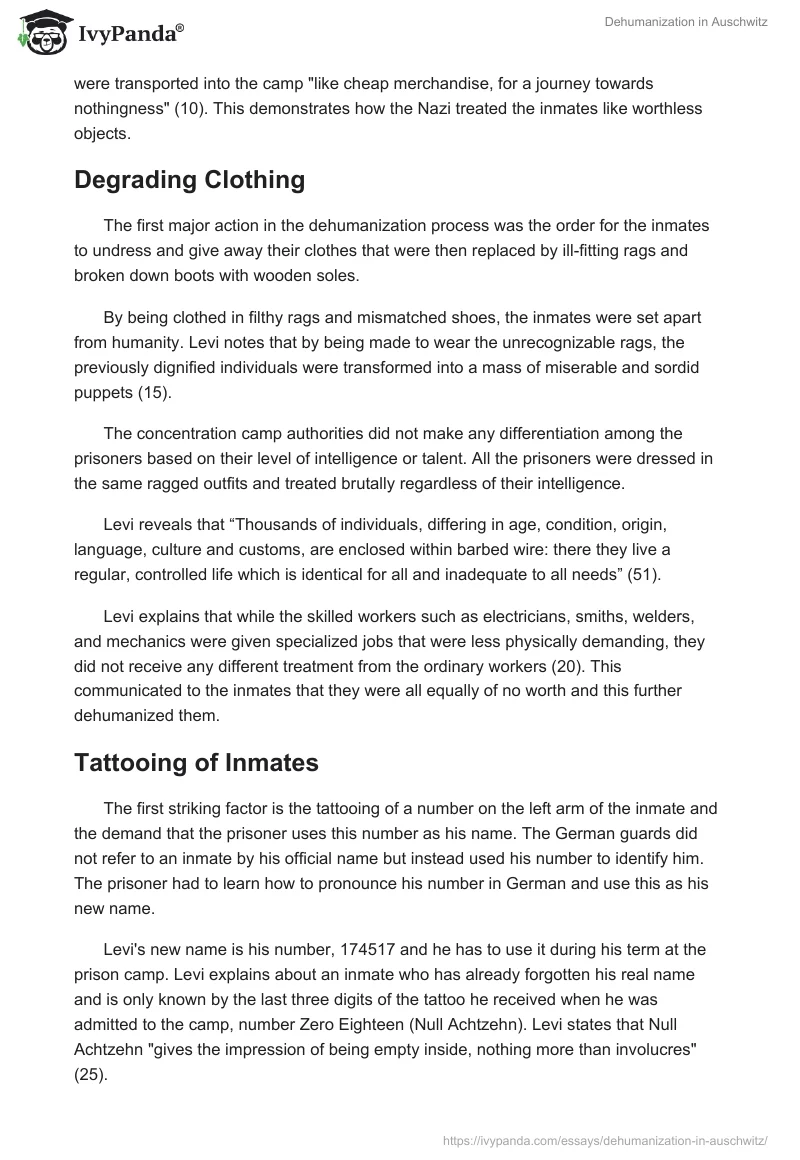Introduction
The Nazi rule in Germany is considered to be the most oppressive and discriminative rule in modern times. During this rule, which lasted until the end of the Second World War, the Nazi engaged in widespread discrimination against European Jews.
This deep anti-Semitism resulted in a master plan created by the Nazi to exterminate all the Jews of Europe. To carry out this task, the Nazi regime built many concentration camps and extermination camps where the Jews could be killed in large numbers.
The most infamous Nazi death camp was Auschwitz concentration camp, where at least one million Jewish prisoners were killed. Before being killed, the prisoners were taken through a process of dehumanization by the Nazi guards.
The book “Survival in Auschwitz” by Primo Levi provides an in-depth narration on the dehumanization process carried out by the Nazi against the Jewish prisoners. While Levi assets that all the action carried out against the prisoners were meant to dehumanize them, some actions were more striking to me than others.
Dehumanization Process
Language Used
The Nazis manipulated language in order to dehumanize the Jews in a number of ways. Language was used to reduce the status of Jews creating a sense of dehumanization. As Levi and the other Jews are being counted for transportation, the Corporal states that there are “six hundred and fifty pieces” referring to the number of Jews available for transportation (9).
The Jews were referred to as pieces which reduced them to mere commodities that could be treated in any way and even killed without regard. Levi describes that they were transported into the camp “like cheap merchandise, for a journey towards nothingness” (10). This demonstrates how the Nazi treated the inmates like worthless objects.
Degrading Clothing
The first major action in the dehumanization process was the order for the inmates to undress and give away their clothes that were then replaced by ill-fitting rags and broken down boots with wooden soles.
By being clothed in filthy rags and mismatched shoes, the inmates were set apart from humanity. Levi notes that by being made to wear the unrecognizable rags, the previously dignified individuals were transformed into a mass of miserable and sordid puppets (15).
The concentration camp authorities did not make any differentiation among the prisoners based on their level of intelligence or talent. All the prisoners were dressed in the same ragged outfits and treated brutally regardless of their intelligence.
Levi reveals that “Thousands of individuals, differing in age, condition, origin, language, culture and customs, are enclosed within barbed wire: there they live a regular, controlled life which is identical for all and inadequate to all needs” (51).
Levi explains that while the skilled workers such as electricians, smiths, welders, and mechanics were given specialized jobs that were less physically demanding, they did not receive any different treatment from the ordinary workers (20). This communicated to the inmates that they were all equally of no worth and this further dehumanized them.
Tattooing of Inmates
The first striking factor is the tattooing of a number on the left arm of the inmate and the demand that the prisoner uses this number as his name. The German guards did not refer to an inmate by his official name but instead used his number to identify him. The prisoner had to learn how to pronounce his number in German and use this as his new name.
Levi’s new name is his number, 174517 and he has to use it during his term at the prison camp. Levi explains about an inmate who has already forgotten his real name and is only known by the last three digits of the tattoo he received when he was admitted to the camp, number Zero Eighteen (Null Achtzehn). Levi states that Null Achtzehn “gives the impression of being empty inside, nothing more than involucres” (25).
A person’s name gives him a sense of identity and preserves his humanity. By taking away the inmates’ names, the Nazi attempted to encourage the loss of sense of self in the prisoners. These attempts at times succeeded and the person was reduced to an empty object.
This was the case with Null Achtzehn who humanness appears to have been lost with his name. This character is indifferent to everything around him and appears to have lost all will to struggle for survival. Levi compares Null Achtzehn to the sledge-dogs that have no purpose of living and slave until their last breath and die (25).
Poor Living Conditions
The inmates were housed under sub-human living conditions where even the minimum level of hygiene was impossible to maintain. The living quarters of the inmates are small huts that are overcrowded. The prisoners are required to sleep on uncomfortable bunks made of planks of food covered by straw and due to overcrowding, at two individuals occupy almost all the bunks (Levi 29).
The inmates were not able to sleep in stretched out conditions due to overcrowding in the living quarters. The inmates suffered from constant physical pains as they tried to sleep on the hard bunks in twisted immobile positions. Adding to the discomfort of living in the crowded space, the inmates are surrounded by filth and depravity. Prisoners were forced to sleep next to their neighbours who had feet soaked in urine and human waste.
This occurred when a person was made to go empty the bucket of human waste into the latrine late at night. During the transportation process, the content of the overflowing bucket of waste would spill to the person’s feet but he would not be permitted to wash off the waste when he returned to sleep.
These sub-human living conditions essentially reduce the men to living in animal like conditions. It is hard to maintain the sense of human dignity and self-respect when you are living in detestable conditions surrounded by waste and misery.
Levi considers himself lucky when he finds an empty bunk during his first day. He stretches himself out happily and is delighted at having a hard block of wood to sleep on (Levi 29). This illustrates how the dehumanization process reduced the aspirations of the inmates since a free person would not have delighted in sleeping on a hard plank of wood.
Why did the Nazis use dehumanization?
The Nazis made use of dehumanization for a number of practical reasons. Through the dehumanization process, the Nazi were able to alienate the Jewish people from the rest of the human community.
From the moment where they were clothed in rags and mismatched shoes, the inmates appeared different from the other people. Levi declares that this is the “”the demolition of a man” (15). Any ill treatment towards them was therefore justified since they were not viewed as a part of the human community.
Dehumanization was also needed to enable the Nazi guards to carry out their brutal treatment of the Jews without being overcome by guilt. By systematically dehumanizing the inmates, the guards were able to rationalize the severe acts carried out against prisoners since the prisoners were viewed as less than human.
Through dehumanizing activities such as pointless and vicious brutality against inmates, the guards were able to convince themselves that the prisoners deserved the treatment they got. Levi reveals that the guards “have no scruples about beating us up without a reason” (57). By dehumanizing the inmates, the Nazi were able to reduce Jews to the level of animals. They could then control and kill them without any remorse.
Dehumanization reduced the level of resistance from the inmates. Due to the dehumanization process, the inmates were made to forget about the notion of basic human rights. The process reduced the aspirations of the prisoners and for most of them, their only desire was to survive. Levi declares, “We are slaves, deprived of every right” (23). They did not expect any justice and were satisfied with being alive.
The dehumanization process removed all aspects of self-respect and human dignity in the prisoners with survival being the primary goal for most. There is little unity among the inmates as can be seen from the case of Moischl who condemns his accomplice to a flogging by the guards (54). Dehumanization therefore makes it each for the Nazis to handle the inmates.
Conclusion
This paper set out to highlight some of the outstanding dehumanization activities carried out by the Nazi against the inmates at Auschwitz. The paper has noted that while there were many dehumanizing actions, some of the most striking ones were: clothing the inmates in rags, tattooing the prisoners, and providing dilapidated living conditions for the inmates.
The paper has highlighted some of the horrible experiences that the inmates experienced in the process of dehumanization. The paper has shown that the actions of the Nazi were very effective in reducing the inmates to sub-human level. After some time, some of the inmates became completely dehumanized and lost their sense of humanness.
Works Cited
Levi, Primo. Survival in Auschwitz. NY: Simon & Schuster, 1996. Print.


